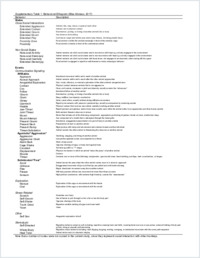Functional organization of the medial temporal lobe memory system following neonatal hippocampal lesion in rhesus monkeys
- Chareyron, Loïc J. Laboratory of Brain and Cognitive Development, Department of MedicineUniversity of Fribourg, Switzerland
- Lavenex, Pamela Banta Laboratory of Brain and Cognitive Development, Institute of PsychologyUniversity of Lausanne, Switzerland
- Amaral, David G. Department of Psychiatry and Behavioral Sciences, Center for Neuroscience, California National Primate Research CenterMIND Institute, UC Davis, USA
- Lavenex, Pierre Laboratory of Brain and Cognitive Development, Department of MedicineUniversity of Fribourg, Switzerland - Laboratory of Brain and Cognitive Development, Institute of PsychologyUniversity of Lausanne, Switzerland
-
01.12.2017
Published in:
- Brain Structure and Function. - 2017, vol. 222, no. 9, p. 3899–3914
English
Hippocampal damage in adult humans impairs episodic and semantic memory, whereas hippocampal damage early in life impairs episodic memory but leaves semantic learning relatively preserved. We have previously shown a similar behavioral dissociation in nonhuman primates. Hippocampal lesion in adult monkeys prevents allocentric spatial relational learning, whereas spatial learning persists following neonatal lesion. Here, we quantified the number of cells expressing the immediate– early gene c-fos, a marker of neuronal activity, to characterize the functional organization of the medial temporal lobe memory system following neonatal hippocampal lesion. Ninety minutes before brain collection, three control and four adult monkeys with bilateral neonatal hippocampal lesions explored a novel environment to activate brain structures involved in spatial learning. Three other adult monkeys with neonatal hippocampal lesions remained in their housing quarters. In unlesioned monkeys, we found high levels of c-fos expression in the intermediate and caudal regions of the entorhinal cortex, and in the perirhinal, parahippocampal, and retrosplenial cortices. In lesioned monkeys, spatial exploration induced an increase in c-fos expression in the intermediate field of the entorhinal cortex, the perirhinal, parahippocampal, and retrosplenial cortices, but not in the caudal entorhinal cortex. These findings suggest that different regions of the medial temporal lobe memory system may require different types of interaction with the hippocampus in support of memory. The caudal perirhinal cortex, the parahippocampal cortex, and the retrosplenial cortex may contribute to spatial learning in the absence of functional hippocampal circuits, whereas the caudal entorhinal cortex may require hippocampal output to support spatial learning.
- Faculty
- Faculté des sciences et de médecine
- Department
- Département de Médecine
- Language
-
- English
- Classification
- Biological sciences
- License
- License undefined
- Identifiers
-
- RERO DOC 306271
- DOI 10.1007/s00429-017-1441-z
- Persistent URL
- https://folia.unifr.ch/unifr/documents/306207
Other files
Statistics
Document views: 72
File downloads:
- lav_fom.pdf: 91
- lav_fom_sm.pdf: 77

